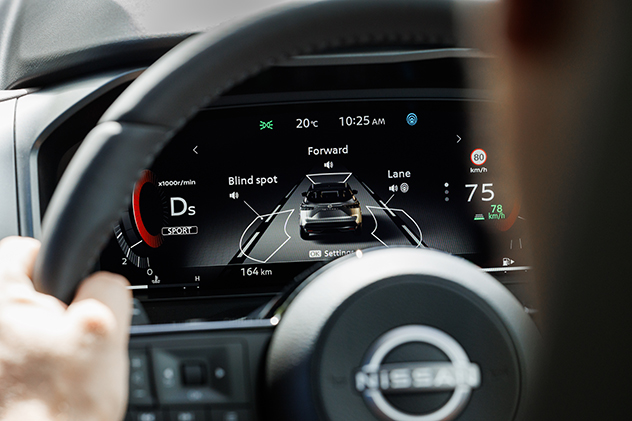2025 Nissan Qashqai review

It wasn’t too long ago that the current-generation Nissan Qashqai small SUV landed in Australia, about three years behind other markets. Now, just a year-and-a-half after its Aussie launch, it’s been updated with refreshed styling and additional standard tech, and is also backed by a more comprehensive warranty than ever.
Possible cause for grief for those who purchased a Qashqai within the last 18 months, but great news for those who’ve been on the fence. Let’s dive into what the updated Qashqai offers.
How much does the 2025 Nissan Qashqai cost?
Despite a rejigged naming convention for variants within the Qashqai range (to align it more neatly with spec hierarchies found in other Nissan model line-ups), relative pricing remains unaltered.
Base ST (unchanged) gets the ball rolling with an MSRP of $34,665, then the range progresses through ST-L (previously ST+) for $38,665, Ti (previously ST-L) for $38,665, and Ti-L (previously Ti) for $42,965. An e-Power hybrid powertrain (more on that later) can be optioned on Ti-L for an additional $4200, taking the total price to $52,365.
Fresh to the range, and assuming new flagship status, is an N-Design trim which can only be had with an e-Power configuration, costing buyers $54,365.
Introductory pricing (available until 30 April 2025) sees the ST launch at just $32,665 and the ST-L for $37,665 MSRP.
The 2025 Qashqai is the first new model to be launched by Nissan Australia following its announcement to move to a conditional 10-year/300,000km warranty and five-year, unlimited km roadside assistance service.
Buyers who opt to service outside of Nissan’s network get a five-year, unlimited km warranty and one-year, unlimited km roadside assistance bundle as standard.
What is the 2025 Nissan Qashqai like inside?
Inside, the Qashqai feels like the well-developed car it ought to. Consistent with siblings in the Nissan family, touch points have a sensible layout and solid feel, with refined ergonomics and comfort for both driver and passengers.
Ti grade and up score a 12.3-inch driver display, matching the 12.3-inch centre touchscreen now standard across the range.
Regardless of what it’s trimmed in, the steering wheel is comfortable in the hand. Its chunky styling and buttons would feel more at home in Nissan’s more utilitarian models, though, seemingly at odds with the sharp design seen elsewhere both inside and out.
The N-Design trim’s interior is exceptional for the price point, lashing Alcantara leather throughout the interior and on the front seats.










— Liam Murphy
How safe is the 2025 Nissan Qashqai?
The 2025 Nissan Qashqai gets a five-star ANCAP safety score, carried over from its pre-facelift predecessor.
No surprise there, really, when even base Qashqai comes with a comprehensive suite of safety technologies, including a rear-view camera and parking sensors, forward-collision warning with autonomous emergency braking (capable of pedestrian and cyclist detection), lane departure and blind spot warnings (with intervention for the latter) and cross-traffic alerts to name a few.
ST and up also get 360-degree monitoring with moving object detection and front parking sensors, while e-Power-fitted Ti-L and N-Design score an intelligent park assist function.

Advanced Drive-Assist Display in Nissan Qashqai Ti
What powers the 2025 Nissan Qashqai?
Mechanically identical to the pre-facelift model, the 2025 Qashqai is offered with two powertrains: a conventional internal combustion engine (ICE) or Nissan’s bespoke e-Power hybrid system.
Powering ICE variants is a 1.3-litre turbocharged petrol three-cylinder unit, sending 110kW and 250Nm to the front wheels through a constantly variable transmission (CVT), and is available on all variants except for N-Design.
Nissan’s e-Power hybrid system uses a 1.5-litre turbocharged petrol three-cylinder to act like a generator for an electric motor that drives the front wheels. The system can generate 140kW and 330Nm with a 2.1kWh battery pack able to provide electric-only driving for short stints. It is available only in Ti-L and N-Design grades.
Nissan claims consumption figures of 6.1L/100km and 5.2L/100km for ICE and e-Power variants respectively.










What is the 2025 Nissan Qashqai like to drive?
Something both powertrain variants share is a cabin that well insulates drivers from the outside world. The Qashqai delivers on the solid, dependable feeling buyers would expect from the Nissan badge it wears, providing good wind and road noise suppression.
Handling and steering feedback are dependable for the most part, however the ride teeters on the stiffer end of the spectrum. While mostly composed, the Qashqai struggles with larger bumps, with more jars and shudders making their way back through the steering wheel than they should.
Despite the additional 204kg of weight the e-Power system adds to the ICE Qashqai, we found the ride arguably improved in e-Power variants – perhaps due to this added heft forcing compliance from its suspension rather than asking politely.
Both powertrains provide good response and power delivery, and with the weight offset, the e-Power’s additional power and torque only translate to slightly faster acceleration. Thanks to turbo torque, ICE variants also don’t need to sit screaming in the higher RPMs to give any sort of acceleration, something that often plagues CVT-equipped models.
But ultimately, the e-Power cannot be beaten for refinement by the ICE unit, providing near-electric vehicle levels of smoothness and response. For buyers with the budget to spare, the e-Power really is the next level of driving enjoyment. We spoke more about the powertrain when we drove it last year.

Nissan Qashqai e-POWER N-Design model shown
Open Road’s take on the 2025 Nissan Qashqai
It doesn’t take a rocket scientist to figure it out: take what’s already a good car, add more standard equipment, increase its factory-backing, don’t increase the price, and bag yourself a winner.
The 2025 Nissan Qashqai is a step in the right direction in every way.







